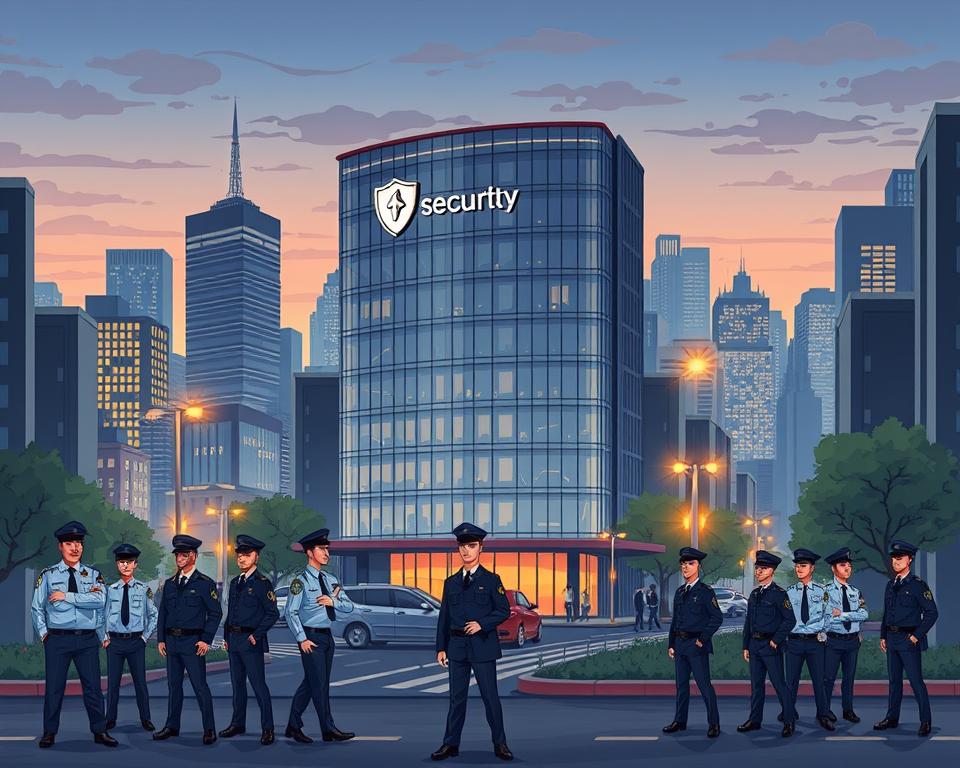Strengthen Your Construction Site Safety Now
Imagine stepping onto your construction site later only to find essential gear missing and even machinery defaced. How soon could setbacks such as these disrupt deadlines as well as cost estimates? Projects frequently house high-value items in unsecured zones, thus leaving them prone to theft. Without proper safeguards, you’re not only risking materials—you’re jeopardizing all your your crew has constructed.
Burglars regularly target areas with limited surveillance, particularly at night. Mobile machinery theft alone costs companies millions annually. Setbacks from replacing stolen items and repairing damage add stress as well as surprise bills. Fortunately: preemptive construction security guards security planning will turn vulnerabilities into strengths.
Divine Protection Services focuses on bespoke security solutions for dynamic environments. The approaches combine advanced technology with hands-on expertise to help keep your investments secure. In the sections that follow, you’ll discover concrete measures for deterring theft, control access, and continue progress without compromises.
Ready to change how you protect your site? Let’s explore real-world strategies designed to combine efficiency and solid protection.
Grasping Construction Site Security Fundamentals
Annually, vulnerable construction sites face millions in losses as a result of preventable issues. Exposed spaces containing valuable tools and machinery draw opportunistic thieves, particularly when it’s dark. Let’s break down the primary issues as well as why prompt measures are essential.

Where Security Gaps Appear
Unlocked storage containers, unattended supplies, as well as dimly lit areas become easy prey. Recent industry reports show theft spikes by 40% during summer months when projects accelerate. Frequent security gaps are:
- Overnight portable generators
- Copper wire kept in sight
- Minimal perimeter barriers
Expenses Exceeding Stolen Goods
A single stolen excavator can delay timelines by weeks while insurance claims process. Vandalism repairs often exceed $5,000 per incident, quickly eating budgets. Teams then face overtime pay to catch up—a double hit to productivity.
According to safety research, installing motion-sensitive lights cuts after-hours breaches by 60%. Using obvious cameras alongside locked gates deters intruders by indicating high risk.
Putting these fundamentals in place initially, you set up a robust groundwork for next-level measures. Next, we’ll explore tailoring solutions to your location’s unique needs.
Determining Your Site’s Specific Security Needs
Why certain sites are more at risk than others? Every worksite has distinct features that shape its risks. A comprehensive review of your location’s design, processes, and equipment is essential for crafting defenses that truly work.
Pinpointing Location-Specific Risks
Start by mapping high-traffic zones and storage spots. Do costly tools sit in dark corners? Is fencing incomplete near public roads? A safety report states blind spots in busy zones are responsible for 35% of nighttime thefts. Addressing these gaps early prevents headaches later.
Look at how storage methods impact security. For example, copper wiring piled near temporary gates invites trouble. Similarly, portable gear left exposed in fields invites theft. Custom approaches may involve:
- Configuring lights to operate during active hours
- Setting aside lockable areas for valuable equipment
- Updating access routes to limit exposure
A bespoke safety strategy shields your workforce and assets. Preemptive steps lessen delays and preserve budgets. By focusing on your location’s unique needs, you create a shield that adapts as the job evolves.
Implementing Effective Security Measures
Bright perimeter lights serve as more than illumination—they’re the first line of defense. Let us examine real-world enhancements combining tech and intelligent planning to secure your assets.
Lighting That Works Smarter
Lights triggered by motion wipe out hiding spots for unauthorized visitors. One site manager cut after-hours break-ins by 75% by placing these around storage zones. Combine them with:
- Sun-powered luminaires for far-flung spots
- Scheduling that aligns lighting with active hours
- All-weather fixtures for lasting performance
Multi-Functional Barrier Solutions
Strong fencing not only outlines limits but also delays forays. Research revealed chain-link anti-climb fencing lowered intrusion attempts by 60%. Choose materials that:
- Withstand impact from vehicles
- Offer sightlines for security patrols
- Include lockable access points
Clear signage acts like a silent guard. Combining “No Trespassing” signs with alarm decals makes trespassers reconsider. A crew experienced no thefts after placing bilingual signs at entrances.
Current alarm solutions send live notifications to smartphones. Pair them with motion detectors and intelligent locks for multi-tiered defense. Implement weekly crew inspections to confirm everything works correctly—this minor effort avoids major issues later.
By implementing these measures now, you create a safer environment for workers and equipment. Regular updates keep your strategy effective as projects evolve.
Harnessing Technology for Site Protection
No longer must you rely just on padlocks and security patrols. Today’s tools blend innovation with practicality, creating a safety net that works even when you’re off the clock. Let’s examine how intelligent tech options safeguard assets without disrupting operations.
Ever-Vigilant Surveillance
Today’s cameras not only capture footage but also analyze it. Using 4K resolution alongside motion detection allows them to detect odd behavior, such as someone hanging around storage units overnight. One contractor reduced theft by 82% using systems that send alerts to their phones. Available types are:
- Solar-powered security units for distant areas
- Weatherproof designs that withstand harsh conditions
- IR-enabled cameras for crisp nocturnal footage
Continuous recording captures every detail, while motion-activated modes save energy. According to a tech report, merging the two approaches halves false alarms.
Smart Entry, Smarter Control
Access badges simplify tracking without slowing down crews. Badge-scan entry records on-site presence—great for tracking subcontractor access. Perks feature:
- Real-time logs for audits
- Off-site access right updates
- Linking to alarm networks
One project manager shared: “We caught a delivery error fast because our logs showed exactly who accessed the equipment shed.” Guards still play a key role, but tech handles the routine checks, freeing them to focus on high-risk areas.
These solutions augment human oversight rather than replace it. By merging tradition with innovation, you build a defense that’s as dynamic as your worksite.
Enhancing Protection Through Divine Protection Services
When did you last update your project’s security plan in response to fresh risks? Divine Protection Services shines by viewing each job as distinct. Their team starts with in-depth assessments, mapping risks from material storage patterns to local crime trends. It’s not off-the-shelf security—it’s pinpoint accuracy.
Perks of a Tailored Security Consultation
Rather than off-the-shelf tactics, they examine your operations and site context. For example, a recent highway project required adjusting patrol routes based on nearby foot traffic. Outcome: Six straight months without a theft. Their approach consists of:
- On-site evaluations with safety engineers
- Bespoke tech integrations (aerial drones plus ground-based sensors)
- Monthly tactic adjustments to match project shifts
Skilled Security Staff and Guard Approaches
Here, guards are more than lookouts—they’re experts in conflict management and technology. One team prevented $12k in losses by spotting suspicious activity near fuel storage. Their multi-tiered strategy merges:
- 24/7 patrols with randomized schedules
- Live data streams to handheld devices
- Emergency drills for swift response
“We’ve reduced vandalism by 91% on partnered sites,” shares a company lead. Combining human intuition with AI-driven analysis, they craft a forward-thinking shield.
Steps to Block Unauthorized Entry and Theft
Consider intruders wandering onto your premises undetected. Uncontrolled entry points turn projects into playgrounds for opportunists. One unguarded gate or ill-timed delivery can lead to issues—but thoughtful planning prevents intrusions.
Timing and Tracking Matter
Schedule material drop-offs during active hours when teams can supervise. A study reveals 68% of thefts take place during unmonitored overnight hours. Align deliveries with staff availability to ensure someone signs off and stores goods immediately
Creating lockable storage zones with few entry points cuts down on temptation. Assign specific areas for high-value tools, and use tamper-proof containers. One PM mentioned: “With a set spot for each item, missing gear becomes obvious immediately.”
- Close all but main gates during off-hours
- Use RFID tags on equipment for real-time tracking
- Carry out unannounced inspections on shifts
Trained personnel play a key role. Guards who patrol perimeters and check credentials deter trespassers effectively. Combine their presence with electronic logs capturing each entry and exit.
Small changes—like adjusting delivery windows or relocating storage trailers—create big barriers against theft. Review protocols weekly to close gaps before they become liabilities. Integrating logistics with security keeps projects timely and cost-effective.
Securing Sites with Full Risk Mitigation
What will you do if an unexpected storm floods your material yard late at night? While cameras and barriers provide the first line of defense, real security arises from readiness for the unforeseen. Merging insurance with emergency plans builds a net that propels projects forward even amid crises.
Insurance Paired with Practical Planning
Sufficient insurance transforms disasters into controllable setbacks. One contractor avoided $78k in losses after thieves struck—their policy covered replacements without delaying deadlines. But insurance alone isn’t enough. Match it with:
- Recorded equipment lists
- Round-the-clock response teams for security incidents
- Weather-specific evacuation routes
Review your plans each quarter. One crew in the Midwest prevented injuries during a tornado thanks to shelter rehearsals. Their drills lowered evacuation times by 63% against adjacent job sites.
Modern alarm systems now integrate with emergency notifications. When sensors detect flooding or fire, they automatically alert local responders. This dual function helps prevent unauthorized access during chaotic events.
Refresh risk appraisals as projects change. Emerging stages could need extra insurance or updated evacuation paths. A safety director remarks: “View your emergency plan as a living document—it adapts with every obstacle.”
Combining fiscal safety nets and practiced responses shields assets and personnel. Begin modestly: audit policies this week and plan your initial drill. Being prepared today stops panic later.
Tackling Typical Security Issues on Construction Sites
Securing a job site isn’t merely about installing cameras and fences—it involves daily collaboration and clever solutions. Personnel turnover, changing timelines, and site layout changes can challenge even robust strategies. One manager recounted: “We used three security outfits in thirty days—staying uniform was next to impossible.”
Managing Guards and Everyday Security Routines
High turnover rates make training and communication tough. Simplified checklists assist new hires in rapidly understanding patrol paths and reporting procedures. Example: Daily walkthroughs with photo records decreased unresolved problems by 45% on a Texas skyscraper site.
Equipment tracking systems like RFID tags reduce losses. Pair them with locked storage zones for items like power tools. Visible signage designating restricted zones further deters casual intruders. A Florida team saw thefts drop 30% after adding multilingual warnings near material piles.
Time pressures often force rushed decisions. One solution? Pre-scheduled access logs for deliveries and subcontractors. This juggles strict schedules and secure access points. Conducting weekly inspections of storage containers and fuel tanks provides extra oversight without hampering progress.
Projects change fast—yesterday’s storage yard might be tomorrow’s pour site. Routine crew huddles guarantee everyone is aware of protocol changes. One supervisor said: “Covering security adjustments in safety briefings boosts compliance automatically.” Tiny changes maintain security agility as sites transform.
Sustaining Long-Term Security Through Best Practices
Steadiness is what turns quick fixes into lasting protection. Treat your safety strategy as a habit—small, purposeful acts accumulate into robust results. Regular checks and adaptive strategies keep your workspace secure through every project phase.
Establishing Accountability with Regularity
Daily walks let teams spot issues before they escalate. A swift scan of boundaries might find a compromised fence panel or a malfunctioning sensor. One contractor found a breached storage container during their morning check, preventing $8k in losses.
Thorough reports build records that boost accountability. Record weather conditions, gear status, and any odd events. “Digital logs helped us identify a pattern of after-hours deliveries that didn’t match schedules,” shared a safety manager from Arizona.
Blend tangible measures with smart tech for total coverage:
- Enhance fences using tamper-resistant connectors
- Check alarm systems every week
- Utilize geofencing tools to oversee restricted sections
Conduct monthly strategy evaluations so your plan grows with the project. When a Florida team expanded their workspace, they adjusted patrol routes to cover new access points—reducing blind spots by 70%. Start today: assign walk-through buddies, create simple checklists, and celebrate improvements. A specialist said: “Security is like a marathon—every stride matters.”
Combining Everything for a Safeguarded Construction Site
Your project’s victory depends on more than drawings and PPE—it requires tiered defenses that adjust to emerging dangers. Uniting physical obstructions like solid fencing and advanced alarm systems forms a barrier that dissuades trespassers at all times. Ongoing rounds by skilled security guards supply human supervision, while motion-sensing lighting removes potential hiding spots for thieves.
Blocking unauthorized entry kicks off with straightforward measures: lock up high-value items in dedicated storage spots, change access codes weekly, and mount noticeable cameras by access ways. Evidence indicates areas applying these practices experience 70% less theft and vandalism than unguarded sites.
Divine Protection Services excels at developing customized solutions for variable sites. They combine high-tech devices such as infrared detectors with practical tactics—varying patrol times, multi-language signage, and live alerts for breaches. A client sidestepped $50k in losses after the system spotted suspicious movement at the perimeter.
Set to bolster your security? Kick off today by examining weak points and arranging a free consultation. With proactive planning and expert support, you’ll build more than structures—you’ll create peace of mind.
Common Inquiries
Which hazards are most common on construction sites?
Trespassing, equipment theft, and property damage are primary worries. Wide-open areas, pricey gear, and isolated spots commonly lure thieves. Weather and poor lighting can also increase vulnerabilities.
How do I block theft during off-hours?
Employ motion-activated lighting, strong perimeter fences, and obvious surveillance warnings. Lock away expensive items in secure containers. Engage services like Divine Protection Services for overnight patrols and immediate alarm notification.
What security measures work best for temporary projects?
Modular fencing with anti-climb features, solar-powered cameras with cloud storage, and temporary access codes for workers. Positioned motion sensors combined with daily equipment checks uphold monitoring as conditions shift.
Is tech capable of replacing human guards?
Although drones and intelligent cameras boost surveillance, trained guards are still essential. Hybrid models combining AI-powered analytics with live guards, like those offered by verified security providers, create layered protection.
How do I control access without slowing work?
Implement RFID badges or biometric scanners for fast verification. Mark access points clearly and designate separate delivery areas with signage. Schedule material arrivals during active hours to reduce unattended stockpiles.
Does insurance cover stolen materials?
Most insurance policies stipulate proof of appropriate safeguards such as alarm systems or monitored checkpoints. Record every safety step, keep equipment lists with serial IDs, and lodge police reports right after thefts.
How frequently must security protocols change?
Reevaluate measures every week as the project progresses. Upcoming project phases could call for altered camera placements, extra fencing, or revised access rosters. Carry out unannounced checks to confirm compliance with protocols.
Which everyday habits boost long-term safety?
Daily morning meetings to outline hazards, evening equipment shutdown routines, and nighttime perimeter scans. Utilize tools such as SafeSite for instant reporting and electronic logging of site events.
Do visible cameras suffice to keep out intruders?
While helpful, combine them with other deterrents. Display “24/7 Surveillance” notices, install gravel walkways to reveal footprints, and switch up guard patrol schedules. For high-risk zones, install overt camera housings with blinking LEDs alongside hidden backup units.


